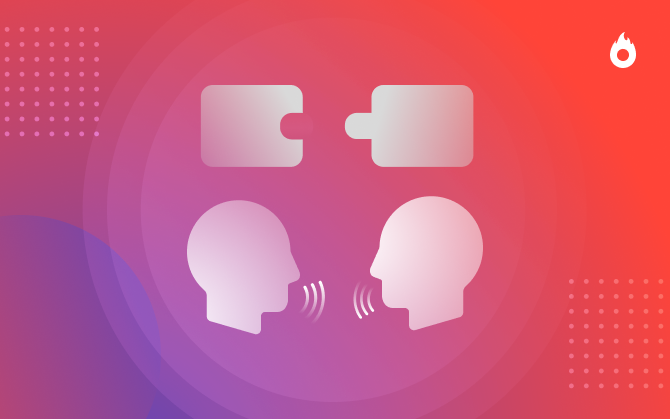
What Is Rapport and How It Can Improve Your Communication
Learn how to build a good relationship with your customers.

What will we see in this post
One of the ways of building more satisfying personal and professional relationships comes to understanding what is rapport. After all, we have all gone through situations in which, even when we offer an advantageous proposal or valuable advice, the counterpart doesn’t seem willing to listen, isn’t that so?
That is why understanding what is rapport is key to building positive relationships to boost your customer base.
The reason is that, in addition to good intentions, we need to establish conditions so that the counterpart can feel at ease to make decisions and act. To do so, it is essential that you create a bond of trust, harmony, and cooperation.
You don’t understand what we’re talking about?
In this post, you’ll learn a little about what is rapport. It’ll help you to be more efficient when you communicate with friends, family members, customers, suppliers, and partners.
What is rapport?
In “Introducing Neuro-Linguistic Programming: Psychological Skills for Understanding and Influencing People“, Joseph O’Connor and John Seymour introduced a concept of rapport linked to the idea of empathy:
In education, therapy, counseling, selling and training, rapport or empathy is essential to establish trust, confidence, and participation, within which people can respond freely.
The notion of “creating an atmosphere” is important so that we don’t confuse rapport with interlocutor manipulation. The goal here is to offer conditions or build certain pillars, which will make communication more efficient.
What are the key elements of rapport?
In interpersonal communication in which rapport exists, we notice certain patterns. If we can incorporate them into our language, we’ll be closer to building pillars of trust, harmony, and cooperation.
Are you ready for the challenge?
Eye contact
In rapport, there’s a synchronism regarding eye contact. The focus is established in the right measure to convey the security, varying in frequency and duration according to the characteristics of the person with whom we speak.
A shy person, for example, will feel more at ease with casual movements, while others will be more comfortable with contacts that are more continuous. It all depends on understanding the situation and calibrating it precisely for each person.
Emotional balance
Another relevant point is to avoid excesses.
Communication is a two-way street in which we both react as well as provoke reactions. Therefore, even if a person says something we don’t like during a conversation, there are limits to our response. Because we might be wrong about the other person’s intentions.
Tone of voice
The tone of voice sometimes communicates more than the words themselves. A simple “good morning” may mean a sincere wish, a mere formality or even a touch of sarcasm.
The manner in which we express ourselves must be compatible with the intention behind what we say.
Progress
Communication must be harmonious. In addition to the tone, we must pay attention to the volume and rhythm used, mirroring our counterpart’s behavior as best as possible.
If a person says something speaking fast and we respond with little energy, we might seem uninterested and not empathetic, just to name one case.
Non-verbal communication
Gestures, posture, and facial expressions also interfere. And this demands special attention because many times we adopt a negative non-verbal communication without being aware of it.
Rapport requires attention to our actions, so that the body is in sync with an atmosphere of trust and participation.
Verbal communication
Words have a double function. In communication, they transmit a message as well as guide the other elements.
In other words, we think our gestures, the tone, and rhythm from what we have to say. Therefore, thinking about the situation through the eyes of others and choosing the right words makes all the difference.
View this post on Instagram
After all, what is rapport and why should we create it?
In communication, we invade personal space, activating all defense mechanisms that involve this movement. Therefore, if the person on the other side doesn’t feel safe and free to participate, the effects might not be the most desired.
Without rapport, students won’t ask questions, nor will customers provide sincere feedback about products. Not to mention those closest to us, who won’t address relationship difficulties in a clear and open manner.
If people have the right to remain silent, as they say in the movies, how can we solve a problem, make a decision together, offer advice or reach any other goal of communication?
Understanding what is rapport is an important step toward improving the efficiency of personal and professional relationships.
How to connect ‘what is rapport’ and sales efficiently?
Attracting customers and building customer loyalty are processes that require rapport. Actually, trust is so important that consumers frequently don’t even fully know the technical aspects of the products they purchase.
When we sell an online course, for example, as much as the program, curriculum and teaching methodology is interesting, people will only truly know the classes when they participate in them. In other words, the sale is a promise of value, which will originate a delivery.
In this sense, the connection between rapport and sales takes place at different stages of the funnel. This is because each step towards acquiring the product or service requires a firmer trust on the supplier’s capacity to deliver.
Customer loyalty, on the other hand, is based on a long-term view. Customers trust that the satisfaction created at first will be repeated in the future, preferring to go back to the services instead of going to a competitor.
Therefore, knowing the recipients’ persona, their desires, expectations, habits, and customs is key. From then on, we can include rapport elements in processes related to sales, creating trust and communicating with harmony.
View this post on Instagram
Check out 3 rapport techniques
In order to build rapport efficiently, the mastery of the techniques will be of crucial importance. Whether in personal or professional contexts, they facilitate the building of elements of an atmosphere of trust and participation.
Mirroring
Reproducing a behavior similar to the interlocutor’s, acting in sync with the tone of voice, gestures, eye contact and progress used.
Mirroring is about observing how a person interacts with whom they are speaking and entering into their world.
Optimism in the interaction process
Developing positive language, avoiding judgments, complaints, criticism and similar actions. In other words, the focus must be on encouragement, problem solving, learning from past experiences.
However, be careful so as not to overdo it. It is natural to have difficulties balancing optimism and mirroring.
If a person is feeling down and you approach them with excessive enthusiasm, there will hardly be any empathy, right?
Therefore, the ideal here is to understand the moment and start with a more reserved attitude, progressing towards more positive behavior.
Good nurturing
Presenting relevant content to someone when starting to communicate. To do so, we need to understand their pain and expectations, and only then, position ourselves as someone who, in fact, has something to offer to solve a problem or help in a given point.
Remember, from what we’ve seen so far, that rapport depends mostly on understanding the person with whom we are talking. This is the gateway to an atmosphere of harmony, trust and cooperation.
Learning about his will be useful in several moments. Our goal might be to present a product, solve a family problem, invest in personal marketing or add professionals to our networking contacts. If there’s good communication, we can benefit from this practice.
So, now that you know what is rapport, the path is open for more satisfying personal and professional relationships.
And you? How have you been communicating with your audience? Let us know here in the comments.





